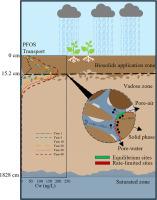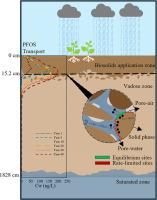全氟和多氟烷基物质(PFAS)从生物固体修正的土壤中迁移:实验和数值方法
IF 12.4
1区 环境科学与生态学
Q1 ENGINEERING, ENVIRONMENTAL
引用次数: 0
摘要
全氟烷基和多氟烷基物质(PFAS)不会在常规废水处理过程中矿化,也不会在出水和生物固体中积累。生物固体的土地施用改善土壤健康;然而,PFAS可能从施用的生物固体中浸出,对地下地下水系统构成威胁。一般来说,控制PFAS从生物固体中浸出的运输机制尚不完全清楚。在这项研究中,两种城市生物固体以农业负荷率与土壤混合,并在饱和流过柱中包装。通过靶向分析、总氧化前体测定(TOP)和可疑筛选对生物固体、生物固体改性土壤(浸出前和浸出后)和柱洗脱液进行分析。利用HYDRUS 1-D对饱和柱结果进行建模,得到输运参数。利用所得参数模拟了两种PFAS在田间相关条件下的长期浸出。柱状体系的质量平衡表明,经过流动实验后,生物固体改性土壤中的大多数前体(>65%)仍被吸附。柱洗脱液TOP分析结果表明,柱实验动员的未知前体中有小部分为短链前体(≤≤C7)。HYDRUS 1-D的迁移模型表明,在饱和条件下,PFAS对生物固体改性土壤的解吸速率有限。利用代表美国中西部上游的条件对全氟辛酸和全氟辛烷磺酸运输进行的长期模拟发现,水溶液浓度分别为107和1ng /L,在每年使用生物固体40年后达到饱和区。这表明,在一些土地应用地点,关注城市生物固体中PFAS的最佳管理实践应包括多途径暴露分析,考虑土壤到地下水的途径,流动性更强的PFAS和浅层土壤和孔隙水,以及植物吸收、径流和土壤排水等过程,流动性更弱的PFAS。本文章由计算机程序翻译,如有差异,请以英文原文为准。


Per- and polyfluoroalkyl substances (PFAS) transport from biosolids-amended soils: An experimental and numerical approach
Per- and polyfluoroalkyl substance (PFAS) do not mineralize in conventional wastewater treatment processes and accumulate in effluents and biosolids. Land-application of biosolids improves soil health; however, PFAS may leach from applied biosolids posing a threat to underlying groundwater systems. In general, transport mechanisms controlling PFAS leaching from biosolids are not fully understood. In this study, two municipal biosolids were mixed with soil at agricultural loading rates and packed in saturated flow-through columns. Biosolids, biosolids-amended soils (pre- and post-leaching) and column eluants were analyzed via targeted analysis, total oxidizable precursor assay (TOP), and suspect screening. Saturated column results were modeled using HYDRUS 1-D to obtain transport parameters. Resulting parameters were used to simulate long-term leaching of two PFAS under field-relevant conditions. Mass balances in column systems show that the majority of precursors (>65 %) in biosolid-amended soils remained sorbed after flow-through experiments. TOP assay results for column eluants suggested that the small fraction of unknown precursors mobilized in column experiments were short-chain precursors (C7). Transport modeling in HYDRUS 1-D demonstrated that PFAS desorption from biosolid-amended soils was rate-limited under saturated conditions. Long-term modeling of perfluorooctanoic acid and perfluorooctane sulfonate transport using conditions representative of the upper midwestern United States found aqueous concentrations of 107 and <1 ng/L, respectively, reaching the saturated zone after 40 yrs of annual biosolids applications. This suggests that at some land application sites, best management practices focused on PFAS in municipal biosolids should include multi-pathway exposure analysis, considering the soil to groundwater pathway for more mobile PFAS and shallow soils and porewater, along with processes such as plant uptake, runoff, and tile drainage for less mobile PFAS.
求助全文
通过发布文献求助,成功后即可免费获取论文全文。
去求助
来源期刊

Water Research
环境科学-工程:环境
CiteScore
20.80
自引率
9.40%
发文量
1307
审稿时长
38 days
期刊介绍:
Water Research, along with its open access companion journal Water Research X, serves as a platform for publishing original research papers covering various aspects of the science and technology related to the anthropogenic water cycle, water quality, and its management worldwide. The audience targeted by the journal comprises biologists, chemical engineers, chemists, civil engineers, environmental engineers, limnologists, and microbiologists. The scope of the journal include:
•Treatment processes for water and wastewaters (municipal, agricultural, industrial, and on-site treatment), including resource recovery and residuals management;
•Urban hydrology including sewer systems, stormwater management, and green infrastructure;
•Drinking water treatment and distribution;
•Potable and non-potable water reuse;
•Sanitation, public health, and risk assessment;
•Anaerobic digestion, solid and hazardous waste management, including source characterization and the effects and control of leachates and gaseous emissions;
•Contaminants (chemical, microbial, anthropogenic particles such as nanoparticles or microplastics) and related water quality sensing, monitoring, fate, and assessment;
•Anthropogenic impacts on inland, tidal, coastal and urban waters, focusing on surface and ground waters, and point and non-point sources of pollution;
•Environmental restoration, linked to surface water, groundwater and groundwater remediation;
•Analysis of the interfaces between sediments and water, and between water and atmosphere, focusing specifically on anthropogenic impacts;
•Mathematical modelling, systems analysis, machine learning, and beneficial use of big data related to the anthropogenic water cycle;
•Socio-economic, policy, and regulations studies.
 求助内容:
求助内容: 应助结果提醒方式:
应助结果提醒方式:


